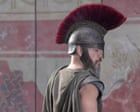
In a world filled with artistic endeavors, cultural heritage, and technological breakthroughs, several recent developments offer a glimpse into the profound ways humanity continues to engage with its past and present. From the cinematic landscapes of Western Sahara to the ancient grounds of Roman Ammaia, these stories encapsulate not only the challenges but also the beauty and complexity of our global narrative.
One of the notable insights comes from the world of film, where acclaimed director Christopher Nolan has found himself at the center of a conversation regarding his recent decision to shoot part of his adaptation of “The Odyssey” in the city of Dakhla, located in the occupied region of Western Sahara. Known for his visionary storytelling, Nolan’s choice of location sparked concerns among the organizers of the FiSahara festival. They caution that such high-profile projects might inadvertently serve to normalize long-standing political tensions. Despite these discussions, the film, featuring actors like Matt Damon and Charlize Theron, is eagerly anticipated for its 2026 release, promising to blend epic narratives with contemporary filmmaking.
Meanwhile, across Asia, a poignant chapter in religious and geopolitical history is unfolding as Tibetan Buddhism faces the impending transition of the Dalai Lama’s leadership. At 90 years old, the current Dalai Lama has been instrumental in guiding Tibetan Buddhism through decades marked by significant changes since the Chinese invasion in the 1950s. As the process to identify his successor begins, the intricate balance between spiritual traditions and political realities presents both challenges and opportunities for dialogue and reflection on Tibet’s future and cultural preservation.
In India, the intersection of technology and cinema takes a novel turn as a 2013 romantic drama, “Raanjhanaa,” undergoes a unique transformation. The film’s storyline, depicting a profound yet tragic cross-cultural romance, is being re-released with an AI-generated “happy ending.” Though the original director was not involved in this creative decision, the reimagined film might offer an interesting case study on the role of artificial intelligence in contemporary storytelling and its implications for artistic integrity.
On a less harmonious note, the emergence of AI-generated content has manifested in worrying ways across social media platforms in France. Using tools like Google’s Veo 3, various accounts have started spreading racially insensitive videos that perpetuate harmful stereotypes under the guise of humor. This phenomenon highlights the urgent need for responsible AI use and the importance of fostering a digital space that respects and values diversity and inclusivity.
Amidst these modern narratives, a journey into history unfolds through archaeological discoveries in the ancient city of Ammaia, located within the serene surroundings of Portugal’s Parque Natural da Serra de São Mamede. Classified as a national monument, Ammaia offers rich insights into Roman life in the region. The recent uncovering of a sepulcher adds to the tapestry of historical knowledge, allowing today’s explorers to connect with stories from an era long past, fueling the imagination and understanding of life in ancient times.
These stories remind us of the diverse tapestry of human experience and the ongoing dialogue between past traditions and new innovations. As we navigate these developments, there lies an opportunity to reflect on the shared challenges and triumphs that unite us across different cultures and histories. Each narrative, whether rooted in art, religion, or history, invites a more profound understanding of our global community, serving as a gentle reminder of the interconnectedness that defines us all.
Source: {link}
